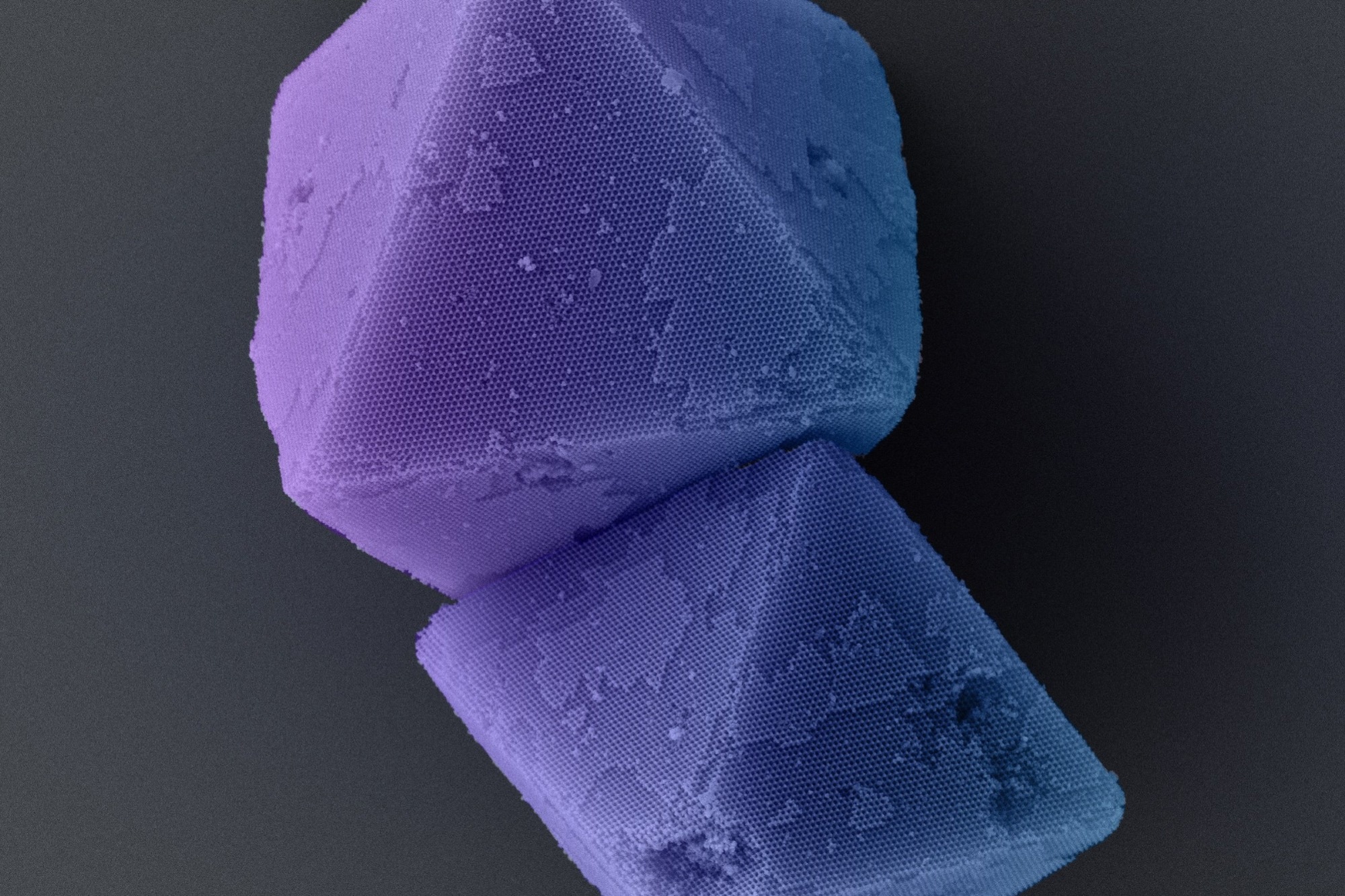Reviewed by Lexie CornerMay 20 2024
In a recent study published in the journal Science, researchers from Ludwig-Maximilian-University utilized DNA origami to construct a diamond lattice with a periodicity spanning hundreds of nanometers. This innovative method represents a novel approach to semiconductor manufacturing tailored for visible light applications.
 Diamond crystals made from DNA. Electron microscope image. color-enhanced. Image Credit: Liedl Lab
Diamond crystals made from DNA. Electron microscope image. color-enhanced. Image Credit: Liedl Lab
The wings of a butterfly do not shimmer because of pigments. Instead, the color display is the result of photonic crystals. Certain wavelengths of light can travel through their periodic nanostructure while other wavelengths are reflected.
This gives the wing scales their striking coloration; they are transparent, after all. Theorists predicted artificial photonic crystals at visible light wavelengths more than 35 years ago. The manufacture of these crystals has since been a major problem and source of motivation for research teams.
Photonic crystals have a versatile range of applications. They have been employed to develop more efficient solar cells, innovative optical waveguides, and materials for quantum communication. However, they have been very laborious to manufacture.
Dr. Gregor Posnjak, Faculty of Physics, Ludwig-Maximilian-University
The Physicist is a Postdoc in the laboratory of Ludwig-Maximilian-University Professor Tim Liedl, whose research is supported by the European Research Council and the “e-conversion” Cluster of Excellence. Through the application of DNA nanotechnology, the group has created a novel method for producing photonic crystals.
Diamond Structure Out of Strands of DNA
The LMU team designed and synthesized building blocks using DNA origami rather than lithographic approaches. The blocks then self-assemble into a unique lattice structure.
It is long been known that the diamond lattice theoretically has an optimal geometry for photonic crystals. In diamonds, each carbon atom is bonded to four other carbon atoms. Our challenge consisted in enlarging the structure of a diamond crystal by a factor of 500 so that the spaces between the building blocks correspond with the wavelength of light.
Tim Liedl, Professor, Faculty of Physics, Ludwig-Maximilian-University
Posnjak said, “We increased the periodicity of the lattice to 170 nm by replacing the individual atoms with larger building blocks–in our case, through DNA origami.”
The Perfect Molecule Folding Technique
The Liedl group is a world-class research team in DNA origami and self-assembly. In the current research, the scientists use 200 small DNA staples and a long, ring-shaped DNA strand (containing about 8,000 bases).
“The latter control the folding of the longer DNA strand into virtually any shape at all – akin to origami masters, who fold pieces of paper into intricate objects. As such, the clamps are a means of determining how the DNA origami objects combine to form the desired diamond lattice,” said the LMU Postdoctoral Researcher.
The 10 µm-sized crystals created by the DNA origami construction blocks are placed on a substrate and transferred to a collaborative research group at the Walter Schottky Institute of the Technical University of Munich (TUM).
Under Professor Ian Sharp's direction, the group deposited individual atomic layers of titanium dioxide on all surfaces of the DNA origami crystals. The “e-conversion” Cluster of Excellence also supports this work.
The DNA origami diamond lattice serves as scaffolding for titanium dioxide, which, on account of its high index of refraction, determines the photonic properties of the lattice. After coating, our photonic crystal does not allow UV light with a wavelength of about 300 nm to pass through, but rather reflects it.
Dr. Gregor Posnjak, Faculty of Physics, Ludwig-Maximilian-University
The titanium dioxide layer's thickness allows for the modification of the reflected light's wavelength.
DNA Origami Could Boost Photonics
Conventional lithographic methods are appropriate for photonic crystals operating in the infrared spectrum but are time-consuming and costly. Lithographic techniques have not proven effective in the visible and ultraviolet light spectrum until now.
Liedl said, “Consequently, the comparatively easy manufacturing process using the self-assembly of DNA origami in an aqueous solution offers a powerful alternative for producing structures in the desired size cost-effectively and in larger quantities.”
He believes that the unique structure, with its enormous chemically accessible pores, will encourage more research, particularly in the area of energy harvesting and storage. A team led by Professor Petr Šulc of Arizona State University and TUM presents a theoretical framework in the same issue of Science for creating different crystalline lattices from patchy colloids.
They also experimentally demonstrate the method by forming a pyrochlore lattice using DNA origami building blocks, which may also have applications in photonics.
Journal Reference:
Posnjak, G., et al. (2024) Diamond-lattice photonic crystals assembled from DNA origami. Science. doi.org/10.1126/science.adl2733
Source: https://www.lmu.de/en/